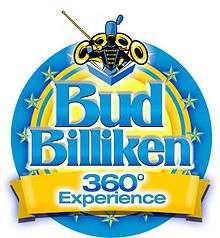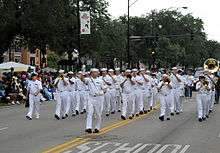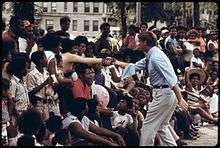Bud Billiken Parade and Picnic
| Bud Billiken Parade and Picnic | |
|---|---|
 | |
 | |
| Status | Active |
| Genre | Parade |
| Frequency | Annual |
| Location(s) |
39th–55th Streets and Dr. Martin Luther King Jr. Drive (Bronzeville/Washington Park neighborhood) Chicago, Illinois |
| Country | United States |
| Years active | 1929–present |
| Founder | Robert S. Abbott (Founder) |
| Most recent | August 13, 2016 |
| Next event | August 12, 2017 |
| Website | |
|
budbillikenparade | |
The Bud Billiken Parade and Picnic (also known as The Bud Billiken Day Parade) is an annual parade held since 1929 in the Bronzeville/Washington Park neighborhood of Chicago, Illinois, United States; it is the largest African-American parade in the nation. It is held annually on the second Saturday in August.[1][2] Robert S. Abbott, the founder and publisher of the Chicago Defender, created the fictional character of Bud Billiken, which he featured in a column in his paper. David Kellum suggested the parade as a celebration of African-American life. It is now the second largest annual parade in the United States.[3] The focus of the parade is on educating Chicago's youth.[4] In the 21st century, the parade features celebrities, politicians, businessmen, civic organizations and youth. It begins in the Bronzeville neighborhood on Chicago's South Side and ends in Washington Park. The parade has been televised on WGN-TV (1978–2012), WLS-TV (1984–present) and WCIU-TV (2012–2014).[5] National and international celebrities have attended and some have served as the parade's Grand Marshal. The 87th Annual Parade took place on August 13, 2016, and was televised on WLS-TV.[6] In 2017, the second Saturday in August falls on August 12.
History



Bud Billiken is a fictional character created in 1923 by Abbott, who had been considering adding a youth section to the Chicago Defender newspaper. While dining at a Chinese restaurant he noticed a Billiken. Some of the early Billiken columns were written by Willard Motley, who later became a prominent novelist. During the early 1930s, names of international youth were listed in the "Bud Billiken" section of the newspaper every week. Between 1930-34, approximately 10,000 names appeared and were archived in the Carter G. Woodson Regional Library of the Chicago Public Library.[7]
During the Great Depression, Abbott featured the Bud Billiken character in his newspaper as a symbol of pride, happiness and hope for black residents.[8] The character gained prominence in a comic strip and the Chicago Defender newspaper.[8] Although the character was created in 1923, the parade did not begin until 1929, when David Kellum initiated it as a celebration of the "unity in diversity for the children of Chicago". It has since grown to become a locally televised event and the second largest parade in the nation.[7]
The parade, which began on August 11, 1929,[9] now includes politicians, beauty queens, celebrities, musical performers, and dozens of marching, tumbling and dancing groups.[8] It has grown from a locally sponsored event to one with major corporate presence and is seen as a signal of the impending end of summer and beginning of the new school year.[8] As such the parade sponsors raise money for college scholarships for local youth.[8] The parade route has changed over the years. The original route was along Michigan Avenue beginning at 31st Street, then turned east into Washington Park. Concern for north-south traffic flow caused rerouting the parade route to South Parkway (now named Dr. Martin Luther King, Jr. Drive), which runs directly into the park. At various times, street repairs have necessitated use of the Michigan route, but the current route is now the King Drive route.[9] Freeman Gosden and Charles Correll of Amos 'n' Andy fame were the first guests of honor in the original parade. Robert S. Abbott led the first parade in his Rolls Royce. Dr. Marjorie Stewart Joyner, president of the Chicago Defender Charities, Inc., organized the parade for over 50 years. Numerous high-profile celebrities and dignitaries have attended the parade over the years, including U.S. President Harry S. Truman, Michael Jordan, Joe Louis, Muhammad Ali, Duke Ellington, Adelaide Hall,[10] Oprah Winfrey, Diana Ross, Lena Horne, Ethel Waters, Cab Calloway, Paul Robeson and Billie Holiday.[8][9] Truman rode alongside John H. Sengstacke, who was Abbott's nephew and took over the Chicago Defender in 1948, and Mayor Richard J. Daley in the 1956 Parade.[11] Recent parades have featured popular musical acts as concert performers at the post-parade picnic. In 2006, approximately 26 million people saw the parade,[6] including 25 million television viewers and 1.2 million attendees.[2] The 2006 parade included 74,000 participants and 160 floats and vehicles.[2] The 2008 parade was dedicated to actor and comedian Bernie Mac (star of The Bernie Mac Show)[12] and a native of Chicago; he died an hour before the start of the parade. In 1993, a request by a black LGBT group to participate in the parade was declined by the organizers. Following legal action and the involvement of Lambda Legal, the Ad Hoc Committee of Proud Black Lesbians and Gays was allowed to participate in the parade.[13][14]
Parade

The parade has categorized contests for participants such as best float, and best marching band.[15] It takes place in Chicago's Bronzeville neighborhood, starting at 35th Street and Dr. Martin Luther King Drive at the southern border of the Douglas community area, south of the landmark Victory Monument. It continues south to 55th Street in Washington Park. This route covers approximately 2 miles (3.2 km). This route takes the parade through the Grand Boulevard and Washington Park community areas.[16]
2007 Parade
At the 78th annual parade in 2007, then-U.S. Senator Barack Obama served as the Grand Marshal for the second year in a row. Chicago Mayor Richard M. Daley attended, and march participants included U.S. Senator Dick Durbin, Lieutenant Governor of Illinois Pat Quinn and the Rev. Al Sharpton.[17] One float represented the Chicago 2016 Committee and included past Chicago Olympians Bob Pickens, Willie May, Diane Simpson-Bundy and Kenny Johnson as well as the son of Danell Nicholson. The Chicago Bulls' mascot made a guest appearance.[18]
Grand Marshal
A notable figure is invited each year to serve as Grand Marshal, often featuring politicians or entertainers. Chicago native and R&B singer Chaka Khan served as Grand Marshal at the 85th annual parade in 2014.[19]
Theme
Bud Billiken Parade is themed every year by the parade committee. The tradition began in 1940 when the parade organizers themed the parade "Americanism" to demonstrate patriotism in the US within the African-American community.[20] Other themes over the years:
- 1940– "Americanism"
- 1993– "Education is here to stay. Don't let drugs, gangs and sex get in the way."[21]
- 1995– "Family: In Partnerships Supporting One Another." [22]
- 1996– "Strengthening Family Through Our Youth."[23]
- 1997– "Let's Parade the Child Stars of Education."[24]
- 1999– "Bud Billiken Salutes Our Children, Our Future."[25]
- 2001– "We Are Family." [26]
- 2004– "A Time to Encourage and Educate Our Youth."[27]
- 2009– "Education, Yes We Can: A Salute to President Barack Obama" [28]
- 2010– "Education: It's the American Way."[29]
- 2011– "Education: Now More Than Ever."[30]
- 2012– "Education: Built To Last"/"A Tribute To President Barack Obama."[31]
- 2013– "Empowerment of Youth through Education."[32]
- 2014– "Education: The One Tool You Can't Lose."[33]
- 2015– "Education: That's an Order."[34]
- 2016– "Uniting the Community through Education for 87 Years." [35]
Picnic
The parade begins at 10 A.M. and ends at 4 P.M. After the parade, visitors are welcomed to stay in Washington Park for a picnic. The picnic has various festivities and vendor booths.[16] The post-parade festivities often include a concert. The 2006 parade featured Yung Joc,[36] and the 2007 parade featured Pretty Ricky.[18][37] However, it seems neither picnic included a concert.
Violence
The 2003 parade featured B2K.[9] The concert was free with virtually unlimited space in the park for viewing. However, the crowd became unruly causing the concert to be curtailed. Over 40 attendees were taken to hospitals as a result of injuries in the violence, including two teenagers who were shot.[38] At the 2014 parade, Two teenagers were shot after an altercation involving a group of youths along the parade route near the 4200 block of King Drive around 12:30 pm.[39][40]
See also
References
- ↑ Jerald Walker, "Dreams From My Father," Mother Jones, January/February 2009, p. 53
- 1 2 3 "Bud Billiken: 78th Annual Parade and Picnic (Parade facts)". Chicago Defender Charities, Inc. 2007. Archived from the original on August 22, 2006. Retrieved July 4, 2007.
- ↑ "ABC 7 Chicago Presents Live Broadcast Of The Bud Billiken Parade". ABC Inc., WLS-TV Chicago. 2006. Retrieved August 14, 2007.
- ↑ Scott, Eugene F. "From the Colonel". Bud Billiken Parade. Retrieved August 2014. Check date values in:
|access-date=(help) - ↑ WGN-TV drops Bud Billiken parade
- 1 2 "ABC7's broadcast of the Bud Billiken Parade". WLS-TV. August 7, 2015. Retrieved August 11, 2015.
- 1 2 "Bud Billiken Parade". 8th Infantry Illinois National Guard Association. Retrieved July 4, 2007.
- 1 2 3 4 5 6 Pierre, Robert E. (August 12, 2002). "What's In A Name? More Than A Parade". The Washington Post. Jesse Jackson, Jr. for Congress. Archived from the original on September 28, 2007. Retrieved July 4, 2007.
- 1 2 3 4 "Bud Billiken: 78th Annual Parade and Picnic (Parade history)". Chicago Defender Charities, Inc. 2007. Archived from the original on September 17, 2007. Retrieved September 17, 2007.
- ↑ The 1933 Chicago World's Fair – Century of Progress, by Cheryl Ganz, published by University of Illinois Press, (January 6, 2012) ISBN 0252078527. Adelaide Hall, Cab Calloway and Earl Hines at the Bud Billiken parade and Picnic reference on page 115: https://books.google.com/books?id=GYXD8t4DDoIC&pg=PT163&dq=adelaide+hall+chicago&hl=en&sa=X&ei=tZdpU5vLI8a_ObH0gcgM&ved=0CGAQ6AEwBw#v=onepage&q=adelaide%20hall%20chicago&f=false
- ↑ Johnson, Dirk (May 26, 2009). "Historical Trove, Freed From Storage, Gets a Home". The New York Times. p. A12. Retrieved September 23, 2009.
- ↑ Le Mignot, Suzanne (August 9, 2008). "Actor And Comedian Bernie Mac Dies At Age 50". CBS2Chicago. Archived from the original on August 22, 2008. Retrieved August 10, 2008.
- ↑ Tracy Baim (September 1, 2008). Out and Proud in Chicago: An Overview of the City's Gay Community. Surrey Books. p. 188. ISBN 978-1-57284-100-0.
- ↑ Ball, Carlos A. (2010). From the Closet to the Courtroom: Five LGBT Rights Lawsuits that Have Changed Our Nation. Boston, Mass: Beacon Press. p. 79. ISBN 9780807001530.
- ↑ "Bud Billiken 78th Annual Parade and Picnic (Best of Parade)". Chicago Defender Charities, Inc. Archived from the original on January 4, 2008. Retrieved September 24, 2007.
- 1 2 "Bud Billiken Parade". University of Chicago Medical Center. 2007. Retrieved September 17, 2007.
- ↑ Martinez, Mai; et al. (August 11, 2007). "Bud Billiken Parade Draws Nearly 1 Million People". CBS Broadcasting. Archived from the original on September 27, 2007. Retrieved August 14, 2007.
- 1 2 Kishter, Lindsay (August 11, 2007). "Bud Billiken parade floats Olympic dreams". Chicago Tribune. Topix LLC. Retrieved September 21, 2007.
- ↑ CBS Chicago: Bud Billiken Parade ‘Like A Big Homecoming’ To Grand Marshal Chaka Khan (August 9, 2014)
- ↑ Bud Billiken Parade
- ↑ Year's Parade African-American Route (Chicago Tribune: August 13, 1993)
- ↑ A Million Chicagoans Can't Be Wrong, It's Bud Billiken Parade Time Again (Chicago Tribune: August 6, 1995)
- ↑ African-American Kids Massive Picnic (Chicago Tribune: August 10, 1996)
- ↑ King And Queen Of Bud Billiken Parade Get Royal Treatment (Chicago Tribune: August 9, 1997)
- ↑ Big Business To Join Billiken Parade (Chicago Tribune: August 13, 1999)
- ↑ Bud Billiken parade ready to roll today/ 'We Are Family' theme will be used to promote going back to school (Chicago Tribune: August 11, 2001)
- ↑ Bud Billiken Parade (Chicago Tribune: August 13, 2004)
- ↑ Bud Billiken Parade: 2009
- ↑ Chicago Radio & Media: '2010 Bud Billiken Parade
- ↑ Chicago Radio & Media: '2011 Bud Billiken Parade
- ↑ Chicago Radio & Media: '2012 Bud Billiken Parade
- ↑ Sponsor Chicago: Bud Billiken Parade
- ↑ ACB7 Chicago: Bud Billiken Parade
- ↑ ABC7 Chicago: ABC7'S BROADCAST OF THE BUD BILLIKEN PARADE
- ↑ ABC7 Chicago - BUD BILLIKEN PARADE 2016
- ↑ "77th Annual Bud Billiken Parade". UnRated. 2007. Retrieved September 17, 2007.
- ↑ "Tha Pope & Pretty Ricky". YouTube, LLC. Archived from the original on December 15, 2015. Retrieved September 17, 2007.
- ↑ Hope, Leah (August 11, 2003). "Concert chaos raises questions of crowd safety". ABC Inc., WLS-TV Chicago. Retrieved September 17, 2007.
- ↑
- ↑
External links
| Wikimedia Commons has media related to Bud Billiken Parade and Picnic. |